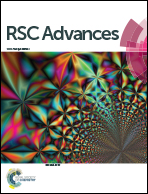Synthesis of flame-retarding oligo(carbonate-ether) diols via double metal cyanide complex-catalyzed copolymerization of PO and CO2 using bisphenol A as a chain transfer agent
Abstract
Flame-retarding oligo(carbonate-ether) diols were successfully prepared with considerable efficiency by copolymerization of propylene oxide (PO) and carbon dioxide (CO2) using a Zn3[Co(CN)6]2-based double metal cyanide complex (DMC) in the presence of bisphenol A (BPA) as a chain transfer agent (CTA). The effects of molar ratio of PO to BPA, temperature, pressure and reaction time on the copolymerization were systematically investigated. The number average molecular weight (Mn) of the oligo(carbonate-ether) diols is in good linear relationship to the molar ratio of PO to BPA and can be facility tuned in the range of 1000–2400 g mol−1 by adjusting reaction temperature and reaction time at fixed PO/BPA = 25.0. Lower temperature and higher CO2 pressure were beneficial for incorporating CO2 into the oligomer chain. The oligomer with a carbonate (CU) of 42% and Mn of 2400 g mol−1 is obtained at 2.0 MPa CO2 pressure and 75 °C with productivity of 2.4 kg g−1 DMC within 6 h.


 Please wait while we load your content...
Please wait while we load your content...